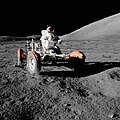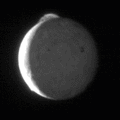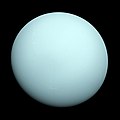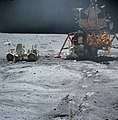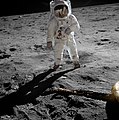Portal maintenance status: (April 2019)
|
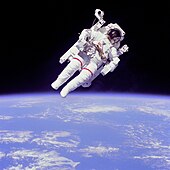
Outer space (or simply space) is the expanse that exists beyond Earth's atmosphere and between celestial bodies. It contains ultra-low levels of particle densities, constituting a near-perfect vacuum of predominantly hydrogen and helium plasma, permeated by electromagnetic radiation, cosmic rays, neutrinos, magnetic fields and dust. The baseline temperature of outer space, as set by the background radiation from the Big Bang, is 2.7 kelvins (−270 °C; −455 °F).
The plasma between galaxies is thought to account for about half of the baryonic (ordinary) matter in the universe, having a number density of less than one hydrogen atom per cubic metre and a kinetic temperature of millions of kelvins. Local concentrations of matter have condensed into stars and galaxies. Intergalactic space takes up most of the volume of the universe, but even galaxies and star systems consist almost entirely of empty space. Most of the remaining mass-energy in the observable universe is made up of an unknown form, dubbed dark matter and dark energy.
Outer space does not begin at a definite altitude above Earth's surface. The Kármán line, an altitude of 100 km (62 mi) above sea level, is conventionally used as the start of outer space in space treaties and for aerospace records keeping. Certain portions of the upper stratosphere and the mesosphere are sometimes referred to as "near space". The framework for international space law was established by the Outer Space Treaty, which entered into force on 10 October 1967. This treaty precludes any claims of national sovereignty and permits all states to freely explore outer space. Despite the drafting of UN resolutions for the peaceful uses of outer space, anti-satellite weapons have been tested in Earth orbit.
The concept that the space between the Earth and the Moon must be a vacuum was first proposed in the 17th century after scientists discovered that air pressure decreased with altitude. The immense scale of outer space was grasped in the 20th century when the distance to the Andromeda Galaxy was first measured. Humans began the physical exploration of space later in the same century with the advent of high-altitude balloon flights. This was followed by crewed rocket flights and, then, crewed Earth orbit, first achieved by Yuri Gagarin of the Soviet Union in 1961. The economic cost of putting objects, including humans, into space is very high, limiting human spaceflight to low Earth orbit and the Moon. On the other hand, uncrewed spacecraft have reached all of the known planets in the Solar System. Outer space represents a challenging environment for human exploration because of the hazards of vacuum and radiation. Microgravity has a negative effect on human physiology that causes both muscle atrophy and bone loss. (Full article...)
The Oort cloud (artist's rendering pictured) is a hypothesized spherical cloud of comets that may lie nearly a light-year from the Sun. It is thought to comprise two separate regions: a spherical outer Oort cloud and a disc-shaped inner Oort cloud, or Hills cloud; the outer extent of the cloud defines the boundary of the Solar System. Objects in the Oort cloud are largely composed of ices, such as water, ammonia, and methane and are thought to have formed close to the Sun, later being scattered into space by the gravitational effects of the giant planets early in the Solar System's evolution. Although no confirmed direct observations of the Oort cloud have been made, astronomers believe that it is the source of all long-period and Halley-type comets entering the inner Solar System, as well as many of the Centaurs and Jupiter-family comets.
-
Image 1Photograph: NASA/JPL-Caltech/University of ArizonaThe Helix Nebula is a large planetary nebula located in the constellation Aquarius. Discovered by Karl Ludwig Harding, probably before 1824, it is one of the closest to Earth of all the bright planetary nebulae, about 215 parsecs (700 light-years) away. It is similar in appearance to the Cat's Eye Nebula and the Ring Nebula.
-
Image 2Image: Tom RuenAn animation of the phases of the Moon. As the Moon revolves around the Earth, the Sun lights the Moon from a different side, creating the different phases. In the image, the Moon appears to get bigger as well as "wobble" slightly. Tidal locking synchronizes the Moon's rotation period on its axis to match its orbital period around the earth. These two periods nearly cancel each other out, except that the Moon's orbit is elliptical. This causes its orbital motion to speed up when closer to the Earth, and slow down when farther away, causing the Moon's apparent diameter to change, as well as the wobbling motion observed.
-
Image 3Photo credit: Harrison SchmittAstronaut Eugene Cernan makes a short test drive of the lunar rover (officially, Lunar Roving Vehicle or LRV) during the early part of the first Apollo 17 extravehicular activity. The LRV was only used in the last three Apollo missions, but it performed without any major problems and allowed the astronauts to cover far more ground than in previous missions. All three LRVs were abandoned on the Moon.
-
Image 4Neptune is the eighth and farthest known planet from the Sun in the Solar System. In the Solar System, it is the fourth-largest planet by diameter, the third-most-massive planet and the densest giant planet. Neptune is 17 times the mass of Earth, slightly more massive than its near-twin Uranus. Neptune is denser and physically smaller than Uranus because its greater mass causes more gravitational compression of its atmosphere. Neptune orbits the Sun once every 164.8 years at an average distance of 30.1 au (4.5 billion km; 2.8 billion mi). It is named after the Roman god of the sea and has the astronomical symbol ♆, a stylised version of the god Neptune's trident.
This picture of Neptune was taken by NASA's Voyager 2 spacecraft in 1989, at a range of 4.4 million miles (7.1 million kilometres) from the planet, approximately four days before closest approach. The photograph shows the Great Dark Spot, a storm about the size of Earth, in the centre, while the fast-moving bright feature nicknamed the "Scooter" and the Small Dark Spot can be seen on the western limb. These clouds were seen to persist for as long as the spacecraft's cameras could resolve them. -
Image 5

Astronaut Bruce McCandless using a Manned Maneuvering Unit Credit: NASAA Manned Maneuvering Unit (MMU) is a jet pack (propulsion backpack that snaps onto the back of the space suit) which has been used on untethered spacewalks from NASA's Space Shuttle, allowing an astronaut to move independently from the shuttle. The MMU was used on three Shuttle missions in 1984. It was first tested on February 7 during mission STS-41-B by astronauts Bruce McCandless II (seen here) and Robert L. Stewart. -
Image 6A timed exposure of the first Space Shuttle mission, STS-1. The shuttle Columbia stands on launch pad A at Kennedy Space Center, the night before launch. The objectives of the maiden flight were to check out the overall Shuttle system, accomplish a safe ascent into orbit and to return to Earth for a safe landing.
-
Image 7Realistic-color mosaic of images of Jupiter's moon Europa taken by NASA's Jupiter orbiter Galileo in 1995 and 1998. This view of the moon's anti-Jovian hemisphere shows numerous lineae, linear features created via a tectonic process in which crustal plates of water ice floating on a subsurface ocean (kept warm by tidal flexing) shift in relative position. Reddish regions are areas where the ice has a higher mineral content. The north polar region is at right. (Geologic features are annotated in Commons.)
-
Image 8Photograph credit: European Space AgencyMars is the fourth planet from the Sun and is known as the "Red Planet" due to its reddish appearance as seen from Earth. The planet is named after Mars, the Roman god of war. A terrestrial planet, Mars has a thin atmosphere and surface features reminiscent both of the impact craters of the Moon and the volcanoes, valleys, deserts and polar ice caps of the Earth. The planet has the highest mountain in the Solar System, Olympus Mons, as well as the largest canyon, Valles Marineris. Mars's rotation period and seasonal cycles are also similar to those of the Earth. Of all the planets in the Solar System other than Earth, Mars is the most likely to harbour liquid water and perhaps life. There are ongoing investigations assessing Mars's past potential for habitability, as well as the possibility of extant life. Future astrobiology missions are planned, including NASA's Mars 2020 rover and the European Space Agency (ESA)'s Rosalind Franklin rover. In November 2016, NASA reported finding a large amount of underground ice in the Utopia Planitia region of the planet. The volume of water detected has been estimated to be equivalent to the volume of water in Lake Superior. Mars has two moons, Phobos and Deimos, which are small and irregularly shaped.
This picture is a true-colour image of Mars, taken from a distance of about 240,000 kilometres (150,000 mi) by the OSIRIS instrument on ESA's Rosetta spacecraft, during its February 2007 flyby of the planet. The image was generated using OSIRIS's orange (red), green and blue filters. -
Image 9Photo credit: New Horizons probeAn animation of an eruption by the Tvashtar Paterae volcanic region on the innermost of Jupiter's Galilean moons, Io. The ejecta plume is 330 km (205 mi) high, though only its uppermost half is visible in this image, as its source lies over the moon's limb on its far side. This animation consists of a sequence of five images taken by NASA's New Horizons probe on March 1, 2007, over the course of eight minutes from 23:50 UTC.
-
Image 10Photo credit: Mars Reconnaissance OrbiterFalse-color Mars Reconnaissance Orbiter image of a side of the Chasma Boreale, a canyon in the polar ice cap of the Planum Boreum (north pole of Mars). Light browns are layers of surface dust, greys and blues are layers of water and carbon dioxide ice. Regular geometric cracking is indicative of higher concentrations of water ice.
The Planum Boreum's permanent ice cap has a maximum depth of 3 km (1.9 mi). It is roughly 1200 km (750 mi) in diameter, an area equivalent to about 1½ times the size of Texas. The Chasma Boreale is up to 100 km (62.5 mi) wide and features scarps up to 2 km (1.25 mi) high. For a comparison, the Grand Canyon is approximately 1.6 km (1 mi) deep in some places and 446 km (279 mi) long but only up to 24 km (15 mi) wide. -
Image 11Six beryllium mirror segments of the James Webb Space Telescope (JWST) undergoing a series of cryogenic tests at NASA's Marshall Space Flight Center in Huntsville, Alabama. The JWST is a planned space telescope that is a joint collaboration of 20 countries. It will orbit the Sun approximately 1,500,000 km (930,000 mi) beyond the Earth, around the L2 Lagrange point. It is expected to launch in December 2021.
-
Image 12Map credit: Ignace-Gaston PardiesIgnace-Gaston Pardies (1636–1673) was a French Catholic priest and scientist. His celestial atlas, entitled Globi coelestis in tabulas planas redacti descriptio, comprised six charts of the night sky and was first published in 1674. The atlas uses a gnomonic projection so that the plates make up a cube of the celestial sphere. The constellation figures are drawn from Uranometria, but were carefully reworked and adapted to a broader view of the sky. This is the second plate from a 1693 edition of Pardies's atlas, featuring constellations including Pegasus and Andromeda, visible in the northern sky.
-
Image 13Uranus is the seventh planet from the Sun and the fourth most massive in the Solar System. In this photograph from 1986 the planet appears almost featureless, but recent terrestrial observations have found seasonal changes to be occurring.
-
Image 14Mercury is the smallest and closest to the Sun of the eight planets in the Solar System. It has no known natural satellites. The planet is named after the Roman deity Mercury, the messenger to the gods.
-
Image 15A composite photo of the Orion Nebula, the closest region of star formation to Earth. It is composed of 520 separate images and NASA calls it "one of the most detailed astronomical images ever produced". The nebula is located below Orion's Belt and is visible to the naked eye at night. It is one of the most scrutinized and photographed objects in the night sky, and is among the most intensely-studied celestial features.
-
Image 16

Color-composite image of the Pleiades from the Digitized Sky Survey Credit: NASA, ESA, AURA/Caltech, Palomar ObservatoryThe Pleiades (also known as M45 or the Seven Sisters) is an open cluster in the constellation of Taurus. It is among the nearest to the Earth of all open clusters, probably the best known and certainly the most striking to the naked eye. -
Image 17

Kepler's Supernova Credit: NASAThis Supernova remnant of Kepler's Supernova (SN 1604) is made up of the materials left behind by the gigantic explosion of a star. There are two possible routes to this end: either a massive star may cease to generate fusion energy in its core, and collapse inward under the force of its own gravity, or a white dwarf star may accumulate material from a companion star until it reaches a critical mass and undergoes a similar collapse. In either case, the resulting supernova explosion expels much or all of the stellar material with great force. -
Image 18The asteroid 433 Eros was named after the Greek god of love Eros. This S-type asteroid is the second-largest near-Earth asteroid. This image shows the view looking from one end of the asteroid across the gouge on its underside and toward the opposite end.
-
Image 19Photograph: NASA, ESA, A. Aloisi (STScI/ESA), and The Hubble Heritage (STScI/AURA)-ESA/Hubble CollaborationAn image of NGC 4449, highlighting its qualities as a starburst galaxy. NGC 4449, an irregular galaxy in the constellation Canes Venatici located about 12 million light years from Earth, has a rate of star formation twice that of the Milky Way's satellite galaxy, the Large Magellanic Cloud. Interactions with nearby galaxies are thought to have influenced this star formation.
-
Image 20Photo: Yuri Beletsky, ESOA laser shoots towards the centre of the Milky Way from the Very Large Telescope facility in Chile, to provide a laser guide star, a reference point in the sky for the telescope's adaptive optics (AO) system. AO technology improves the performance of optical systems by reducing the effect of atmospheric distortion. AO was first envisioned by Horace W. Babcock in 1953, but did not come into common usage until advances in computer technology during the 1990s made the technique practical.
-
Image 21The launch of Space Shuttle Atlantis on STS-98, February 7 2001, at sunset. The sun is behind the camera, and the shape of the plume is cast across the vault of the sky, intersecting the rising full moon. The top portion of the plume is bright because it is illuminated directly by the sun; the lower portions are in the Earth's shadow. After launch, the shuttle must engage in a pitch and roll program so that the vehicle is below the external tank and SRBs, as evidenced in the plume trail. The vehicle climbs in a progressively flattening arc, because achieving low orbit requires much more horizontal than vertical acceleration.
-
Image 22

Planet Mars Credit: NASAMars, the fourth planet from the Sun, is named after the Roman god of war because of its blood red color. Mars has two small, oddly-shaped moons, Phobos and Deimos, named after the sons of the Greek god Ares. At some point in the future Phobos will be broken up by gravitational forces. The atmosphere on Mars is 95% carbon dioxide. In 2003 methane was also discovered in the atmosphere. Since methane is an unstable gas, this indicates that there must be (or have been within the last few hundred years) a source of the gas on the planet.
-
Image 1Timeline of the expansion of the universe, where visible space is represented by the circular sections. At left, a dramatic expansion occurs in the inflationary epoch, and at the center, the expansion accelerates. Neither time nor size are to scale. (from Outer space)
-
Image 2A dusty trail from the early Solar System to carbonaceous dust today. (from Cosmic dust)
-
Image 4For the first time, the NASA / ESA / Canadian Space Agency / James Webb Space Telescope has observed the chemical signature of carbon-rich dust grains at redshift z ≈ 7, which is roughly equivalent to one billion years after the birth of the Universe, this observation suggests exciting avenues of investigation into both the production of cosmic dust and the earliest stellar populations in our Universe. (from Cosmic dust)
-
Image 5Gabbard diagram of almost 300 pieces of debris from the disintegration of the five-month-old third stage of the Chinese Long March 4 booster on 11 March 2000 (from Space debris)
-
Image 6Because of the hazards of a vacuum, astronauts must wear a pressurized space suit while outside their spacecraft.
-
Image 7Atmospheric attenuation in dB/km as a function of frequency over the EHF band. Peaks in absorption at specific frequencies are a problem, due to atmosphere constituents such as water vapor (H2O) and carbon dioxide (CO2). (from Interstellar medium)
-
Image 13Map showing the Sun located near the edge of the Local Interstellar Cloud and Alpha Centauri about 4 light-years away in the neighboring G-Cloud complex (from Interstellar medium)
-
Image 16Bow shock formed by the magnetosphere of the young star LL Orionis (center) as it collides with the Orion Nebula flow
-
Image 17Cosmic dust of the Horsehead Nebula as revealed by the Hubble Space Telescope. (from Cosmic dust)
-
Image 18Astronaut Piers Sellers during the third spacewalk of STS-121, a demonstration of orbiter heat shield repair techniques (from Outline of space science)
-
Image 19NASA computer-generated image of debris objects in Earth orbit, c. 2005. (from Space debris)
-
Image 20Apollo Command Service Module in lunar orbit (from Space exploration)
-
Image 21Artistic image of a rocket lifting from a Saturn moon (from Space exploration)
-
Image 22A computer-generated animation by the European Space Agency representing space debris in low earth orbit at the current rate of growth compared to mitigation measures being taken. (from Space debris)
-
Image 23This light-year-long knot of interstellar gas and dust resembles a caterpillar. (from Interstellar medium)
-
Image 24The distribution of ionized hydrogen (known by astronomers as H II from old spectroscopic terminology) in the parts of the Galactic interstellar medium visible from the Earth's northern hemisphere as observed with the Wisconsin Hα Mapper (Haffner et al. 2003) harv error: no target: CITEREFHaffnerReynoldsTufteMadsen2003 (help). (from Interstellar medium)
-
Image 25Concept art for a NASA Vision mission (from Space exploration)
-
Image 26A laser-guided observation of the Milky Way Galaxy at the Paranal Observatory in Chile in 2010 (from Outline of space science)
-
Image 27The original Magdeburg hemispheres (left) used to demonstrate Otto von Guericke's vacuum pump (right)
-
Image 28Illustration of Earth's atmosphere gradual transition into outer space (from Outer space)
-
Image 30Known orbit planes of Fengyun-1C debris one month after the weather satellite's disintegration by the Chinese ASAT (from Space debris)
-
Image 31Reconstruction of solar activity over 11,400 years. Period of equally high activity over 8,000 years ago marked. (from Space climate)
-
Image 33Apollo 16 LEM Orion, the Lunar Roving Vehicle and astronaut John Young (1972) (from Space exploration)
-
Image 34Concept for a space-based solar power system to beam energy down to Earth (from Outer space)
-
Image 35A wide field view of outer space as seen from Earth's surface at night. The interplanetary dust cloud is visible as the horizontal band of zodiacal light, including the false dawn (edges) and gegenschein (center), which is visually crossed by the Milky Way (from Outer space)
-
Image 38The diversity found in the different types and scales of astronomical objects make the field of study increasingly specialized. (from Outline of space science)
-
Image 39Buzz Aldrin taking a core sample of the Moon during the Apollo 11 mission (from Space exploration)
-
Image 40Illustration of a satellite breaking up into multiple pieces at higher altitudes. (from Space debris)
-
Image 41Debris density in low Earth orbit (from Space debris)
-
Image 42Conventional anti-satellite weapons such as the SM-3 missile remain legal under the law of armed conflict, even though they create hazardous space debris (from Outer space)
-
Image 43The Long Duration Exposure Facility (LDEF) is an important source of information on small-particle space debris. (from Space debris)
-
Image 44View of an orbital debris hole made in the panel of the Solar Max satellite. (from Space debris)
-
Image 45Perseverance's backshell sitting upright on the surface of Jezero Crater (from Space debris)
-
Image 46Growth of tracked objects in orbit and related events; efforts to manage outer space global commons have so far not reduced the debris or the growth of objects in orbit (from Space debris)
-
Image 47Debris impacts on Mir's solar panels degraded their performance. The damage is most noticeable on the panel on the right, which is facing the camera with a high degree of contrast. Extensive damage to the smaller panel below is due to impact with a Progress spacecraft. (from Space debris)
-
Image 49Earth and the Moon as seen from cislunar space on the 2022 Artemis 1 mission (from Outer space)
-
Image 50Spatial density of space debris by altitude according to ESA MASTER-2001, without debris from the Chinese ASAT and 2009 collision events (from Space debris)
-
Image 51Astronaut Buzz Aldrin had a personal Communion service when he first arrived on the surface of the Moon. (from Space exploration)
-
Image 52Spatial density of LEO space debris by altitude, according to 2011 a NASA report to the United Nations Office for Outer Space Affairs (from Space debris)
-
Image 53Model of Vostok spacecraft (from Space exploration)
-
Image 54Smooth chondrite interplanetary dust particle. (from Cosmic dust)
-
Image 55Space debris identified as WT1190F, burning up in a fireball over Sri Lanka. (from Space debris)
-
Image 56The sparse plasma (blue) and dust (white) in the tail of comet Hale–Bopp are being shaped by pressure from solar radiation and the solar wind, respectively.
-
Image 57South is up in the first image of Earth taken by a person, probably by Bill Anders (during the 1968 Apollo 8 mission) (from Outer space)
-
Image 58Spent upper stage of a Delta II rocket, photographed by the XSS 10 satellite (from Space debris)
-
Image 59Large-scale matter distribution in a cubic section of the universe. The blue fiber-like structures represent the matter, and the empty regions in between represent the cosmic voids of the intergalactic medium (from Outer space)
-
Image 60Major elements of 200 stratospheric interplanetary dust particles. (from Cosmic dust)
-
Image 61Infographic showing the space debris situation in different kinds of orbits around Earth (from Space debris)
-
Image 62A micrometeoroid left this crater on the surface of Space Shuttle Challenger's front window on STS-7. (from Space debris)
-
Image 63A proposed timeline of the origin of space, from physical cosmology (from Outline of space science)
-
Image 66A computer-generated map of objects orbiting Earth, as of 2005. About 95% are debris, not working artificial satellites (from Outer space)
-
Image 67After reentry, Delta 2 second stage pieces were found in South Africa. (from Space debris)
-
Image 68Artist's impression of dust formation around a supernova explosion. (from Cosmic dust)
-
Image 69Voyager 1 is the first artificial object to reach the interstellar medium. (from Interstellar medium)
-
Image 70First television image of Earth from space, taken by TIROS-1 (1960) (from Space exploration)
-
Image 72The International Space Station is an orbiting laboratory for space applications and habitability. Visible in the background is yellow-green airglow of Earth's ionosphere and the interstellar field of the Milky Way. (from Outer space)
-
Image 73Space Shuttle Endeavour had a major impact on its radiator during STS-118. The entry hole is about 5.5 mm (0.22 in), and the exit hole is twice as large. (from Space debris)
-
Image 74Cosmic dust of the Andromeda Galaxy as revealed in infrared light by the Spitzer Space Telescope. (from Cosmic dust)
-
Image 75Vanguard 1 is expected to remain in orbit for 240 years. (from Space debris)
-
Image 76A MESSENGER image from 18,000 km showing a region about 500 km across (2008) (from Space exploration)
-
Image 77Near-Earth space showing the low-Earth (blue), medium Earth (green), and high Earth (red) orbits. The last extends beyond the radius of geosynchronous orbits (from Outer space)
-
Image 78Objects in Earth orbit including fragmentation debris, November 2020, NASA: ODPO (from Space debris)
-
Image 79Astronomers used the James Webb Space Telescope to image the warm dust around a nearby young star, Fomalhaut, in order to study the first asteroid belt ever seen outside of the Solar System in infrared light. (from Cosmic dust)

- ... that, for the Space 220 Restaurant, Disney reached out to NASA engineers to understand what a space elevator might look like?
- ... that some severe environmental impacts of the invasion of Ukraine can be seen from space?
- ... that the space industry of India has supported the launch of more than 100 domestic satellites and more than 300 foreign satellites?
- ... that Nature's Fynd, producer of microbe-based meat substitutes, is working with NASA to develop a bioreactor for use in space travel?
- ... that Louis W. Roberts was among the highest ranking African-American space program staff at NASA while the Apollo program was underway?
2024 in space | |||
|---|---|---|---|
| Space probe launches |
| ||
| Impact events | |||
| Selected NEOs | |||
| Discoveries |
| ||
| Comets | |||
For a full schedule of launches and deep-space rendezvous, see 2024 in spaceflight.
|
| Biology |
| |||||
|---|---|---|---|---|---|---|
| Environment | ||||||
| Society | ||||||
| Technology |
| |||||
2020 in space | ||
|---|---|---|
| Space probe launches |
| |
| Impact events | ||
| Selected NEOs |
| |
| Exoplanets |
| |
| Discoveries |
| |
| Comets | ||
| Space exploration |
| |
2019 in space | ||
|---|---|---|
| Space probe launches |
| |
| Impact events |
| |
| Selected NEOs | ||
| Exoplanets |
| |
| Discoveries |
| |
| Comets | ||
| Space exploration |
| |
2018 in space | ||
|---|---|---|
| Space probe launches |
| |
| Impact events | ||
| Selected NEOs | ||
| Exoplanets |
| |
| Discoveries |
| |
| Novae |
| |
| Comets | ||
| Space exploration |
| |
2017 in space | ||
|---|---|---|
| Space probe launches |
| |
| Impact events | ||
| Selected NEOs | ||
| Exoplanets | ||
| Discoveries | ||
| Comets | ||
| Space exploration |
| |
2016 in space | ||
|---|---|---|
| Space probe launches |
| |
| Impact events | ||
| Selected NEOs | ||
| Exoplanets |
| |
| Discoveries |
| |
| Novae | ||
| Comets | ||
| Space exploration | ||
2015 in space | ||||||
|---|---|---|---|---|---|---|
| Space probe launches |
| |||||
| Impact events | ||||||
| Selected NEOs | ||||||
| Exoplanets |
| |||||
| Discoveries |
| |||||
| Comets | ||||||
| Space exploration | ||||||
The following Wikimedia Foundation sister projects provide more on this subject:
-
Commons
Free media repository -
Wikibooks
Free textbooks and manuals -
Wikidata
Free knowledge base -
Wikinews
Free-content news -
Wikiquote
Collection of quotations -
Wikisource
Free-content library -
Wikiversity
Free learning tools -
Wiktionary
Dictionary and thesaurus



